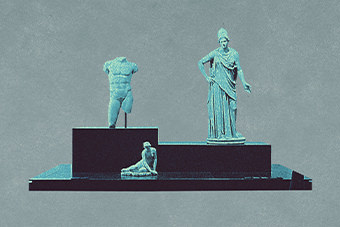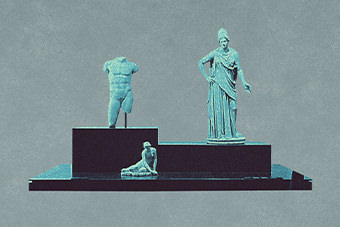Located at the City Palace near Bada Bazar, the Jhalawar Government Museum is an absolute gem. Raj Rana Bhawani Singh started collecting works of art from the Jhalawar State and from his travels abroad and opened a museum outside the Palace gate in 1915. The City Palace itself was built by the first Raj Rana of the new Jhalawar State, Madan Singh, between 1838 and 1845 when the area was called Umedpura Chaoni (military cantonment). The walled city of Jhalrapatan nearby was the capital at that time. Raj Rana Bhawani Singh renamed Umedpura Chaoni as Brijnagar after his wife Brij Kanwar, and it later became Jhalawar.
At Independence, Raj Rana Harischand Singh leased the City Palace to the Government for administrative offices so that Jhalawar could become a district with political representation. When the Palace was finally vacated in 2008 by the district collectorate and the police, it enabled the Rajasthan Archaeological and Museums Department to take over the mardana or eastern wing of the palace for an enlarged museum which opened in 2012. Recent conservation and restoration work of the Palace was awarded to the Delhi based firm Studio Pratap and Partners under the supervision of the Amber Development and Management Authority. There are now 32 galleries of international standards displaying the spectacular collection. A notable sculpture displayed at the museum dates from the 8th Century and comes from Chandrabhaga and Jhalrapatan. The wall paintings of Indian royalty and Nathwada leaders are exceptional.
Jhalawar used to be a cultural hub in the 1920s and Raj Rana Bhawani Singh built the Bhawani Natyashala or Opera House, within the Palace compound, which is being restored for its centenary in 2021. The world-famous sitar maestro Ravi Shankar and his dancer brother Udai grew up in Jhalawar, where their father was in charge of the Opera House. The last music festival there was in 1991 when Ravi Shankar himself played. The building had also been used as a cinema and a badminton hall over the years.
Things to Note:
1) The most famous statue in the collection, the Ardh-Narishwar which shows Shiva as half male and half female, was exhibited in London at the Festival of India in 1982.
2) There are very rare paintings depicting the four Vedas as seated Gods with animal heads: Rig Veda, a donkey-headed God; Yajur Veda, a goat; Sama Veda a horse; and Atharva Veda a monkey-faced God.
3) Many of the stunning wall paintings were painted by Garsiram Hardev Sharma, the head painter at Nathwada who was persuaded to stay in Jhalawar for several years post-1917. He had a large team of painters and was to decorate the painted rooms before the marriage of the Maharaj Kumar Rajendra. Gharsiram’s daughter, Kankudevi, an accomplished artist herself and was part of the team.
More Information
Getting there
Road: Jhalawar can be reached by bus.
Rail: There is a train station, Jhalawar Rd. (JHW) but not many trains run there.
Air: The nearest airport is Bhopal, 199 kms (BHO), Indore, 204 kms (IDR). (Jhalawar has a long runway for charter flights)
Average duration of visit
1-2 hours
Museum administered by
State Government
Person in charge
Updated
This content has been created as part of a project partnered with Royal Rajasthan Foundation, the social impact arm of Rajasthan Royals, to document the cultural heritage of the state of Rajasthan.
Quick Facts
Address:
Garh Palace, Bhoj Mohalla, Jhalawar, Rajasthan - 326001
Visiting Time:
Sunday: 9 am - 5 pm
Monday: Closed
Tuesday: 9 am - 5 pm
Wednesday: 9 am - 5 pm
Thursday: 9 am - 5 pm
Friday: 9 am - 5 pm
Saturday: 9 am - 5 pm
The Museum has a two-hour lunch break from 1 pm to 3 pm.
Phone:
+91-(0743)-2230099Entry Fees:
Adults (Indian nationals): Rs. 20/-
Children (Indian nationals): Rs. 10/-
Adults (Foreign nationals: Rs. 100/-
Children (Foreign nationals): Rs. 50/-




